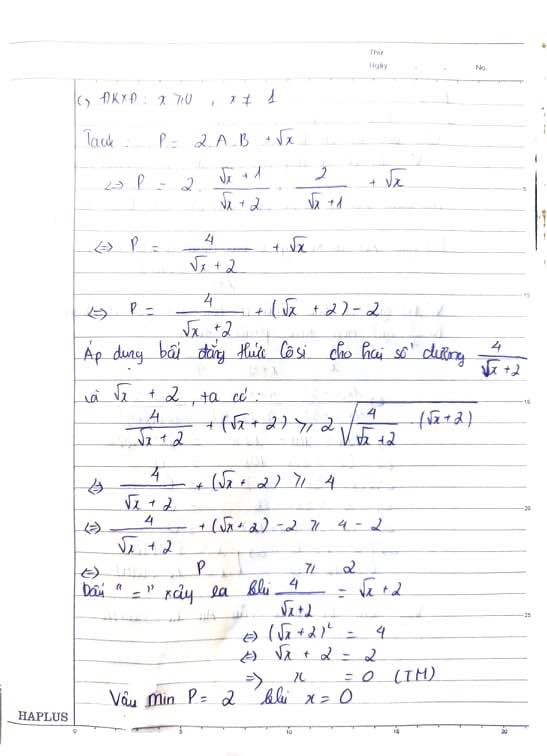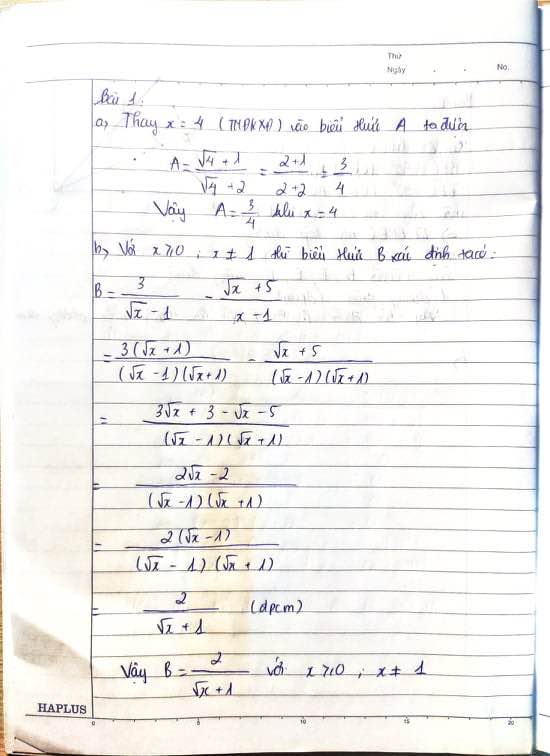Cho hai biểu thức $A = \dfrac{\sqrt x + 1}{\sqrt x+2}$ và $B = \dfrac3{\sqrt x-1} - \dfrac{\sqrt x+5}{x-1}$ với $x \ge 0,$ $x \ne 1$.
1. Tính giá trị của biểu thức $A$ khi $x = 4$.
2. Chứng minh $B = \dfrac2{\sqrt x+1}$.
3. Tìm tất cả các giá trị của $x$ để biểu thức $P = 2A.B + \sqrt x$ đạt giá trị nhỏ nhất.
a, Ta có : \(x=4\Rightarrow\sqrt{x}=2\)
\(\Rightarrow A=\frac{2+1}{2+2}=\frac{3}{4}\)
Vậy với x = 4 thì A = 3/4
b, \(B=\frac{3}{\sqrt{x}-1}-\frac{\sqrt{x}+5}{x-1}=\frac{3\left(\sqrt{x}+1\right)-\sqrt{x}-5}{\left(\sqrt{x}+1\right)\left(\sqrt{x}-1\right)}\)
\(=\frac{3\sqrt{x}+3-\sqrt{x}-5}{\left(\sqrt{x}-1\right)\left(\sqrt{x}+1\right)}=\frac{2\sqrt{x}-2}{\left(\sqrt{x}-1\right)\left(\sqrt{x}+1\right)}=\frac{2}{\sqrt{x}+1}\)( đpcm )
với x=4(t/m DK)
=>\(\sqrt{x}\)=2
thay\(\sqrt{x}\)=2 vào biểu thức A ta được
A=(2+1)/(2+2)
A=3/4
1.
Thay (thỏa mãn ĐKXĐ) vào biểu thức ta có
.
2.
Với ta có
3.
.
Ta có với mọi .
Suy ra . Đẳng thức xảy ra khi và chỉ khi
Vậy thì biểu thức đạt giá trị nhỏ nhất.
1. Thay x=4 vào biểu thức A ta được:
\(\dfrac{\sqrt{4}+1}{\sqrt{4}+2}=\dfrac{2+1}{2+2}=\dfrac{3}{4}\)
Vậy với x=4 thì A=\(\dfrac{3}{4}\)
1;A=\(\dfrac{3}{2}\)
2\(\dfrac{3}{\sqrt{x}-1}-\dfrac{\sqrt{x}+5}{x-1}=\dfrac{3.\left(\sqrt{x}+1\right)-\sqrt{x}-5}{\left(\sqrt{x}-1\right)\left(\sqrt{x}+1\right)}=\dfrac{3\sqrt{x}+3-\sqrt{x}-5}{\left(\sqrt{x}-1\right)\left(\sqrt{x}+1\right)}=\dfrac{2\sqrt{x}-2}{\left(\sqrt{x}-1\right)\left(\sqrt{x}+1\right)}=\dfrac{2\left(\sqrt{x}-1\right)}{\left(\sqrt{x}-1\right)\left(\sqrt{x}+1\right)}=\dfrac{2}{\sqrt{x}+1}\)
1thay x=4 vào A ta có căn 4 +1/căn 4 +2 = 3/4
2
3(căn x +1) / (căn x -1).(căn x+1) -căn x +5 / x-1
(=) 3 căn x +3 / x-1 - căn x +5 / x-1
(=)3 căn x +3 -căn x-5 / x-1
(=) 2 căn x -2 / x-1
(=) 2 / căn x +1
3 2A.B+ căn x = 2 căn x + 1 / căn x +2 . 2 / căn x +1 +căn x
=4 / căn x +2 + căn x lớn hơn hoặc bằng 0 với mọi x lớn hơn hoặc bằng 0
Ta có P lớn hơn hoặc bằng 2 khi x=0
vậy với x=0 thì biểu thức B đạt giá trị nhỏ nhất
1.
Thay (thỏa mãn ĐKXĐ) vào biểu thức ta có
.
2.
Với ta có
3.
.
Ta có với mọi .
Suy ra . Đẳng thức xảy ra khi và chỉ khi
Vậy thì biểu thức đạt giá trị nhỏ nhất.
Điều kiện: x ≥ 0, x 1
1. Thay x = 4 vào biểu thứ A (thỏa mãn điều kiện) ta có:
A = \(\dfrac{\sqrt{x}+1}{\sqrt{x}+2}=\dfrac{\sqrt{4}+1}{\sqrt{4}+2}=\dfrac{2+1}{2+2}=\dfrac{3}{4}\)
Vậy khi x = 4 thì A = \(\dfrac{3}{4}\)
2. B = \(\dfrac{3}{\sqrt{x}-1}-\dfrac{\sqrt{x}+5}{x-1}\)
= \(\dfrac{3\left(\sqrt{x}+1\right)}{\left(\sqrt{x}-1\right)\left(\sqrt{x}+1\right)}-\dfrac{\sqrt{x}+5}{\left(\sqrt{x}-1\right)\left(\sqrt{x}+1\right)}\)
= \(\dfrac{3\sqrt{x}+3-\sqrt{x}-5}{\left(\sqrt{x}-1\right)\left(\sqrt{x}+1\right)}\)
= \(\dfrac{2\sqrt{x}-2}{\left(\sqrt{x}-1\right)\left(\sqrt{x}+1\right)}\)
= \(\dfrac{2\left(\sqrt{x}-1\right)}{\left(\sqrt{x}-1\right)\left(\sqrt{x}+1\right)}\)
= \(\dfrac{2}{\sqrt{x}+1}\left(đpcm\right)\)
Vậy B = \(\dfrac{2}{\sqrt{x}+1}\)A=\(\dfrac{3}{4}\)
x=0
1:\(thay\:x=4\left(TMĐK\right)vào\:biểu\:thức\:A,ta\:được:\dfrac{\sqrt{4}+1}{\sqrt{4}+2}=\dfrac{3}{4}\)
Vậy A =\(\dfrac{3}{4}Tại\:x=4\)
1.Thay x=4 vào biểu thức A
ta có: A=\(\dfrac{\sqrt{4}+1}{\sqrt{4}+2}\)
A=\(\dfrac{2+1}{2+2}\)
A=\(\dfrac{3}{4}\) Vậy A = \(\dfrac{3}{4}\) khi x = 4
2. B= \(\dfrac{3\left(\sqrt{x}+1\right)}{\left(\sqrt{x}-1\right)\left(\sqrt{x}+1\right)}\)-\(\dfrac{\sqrt{x}+5}{\left(\sqrt{x}-1\right)\left(\sqrt{x}+1\right)}\)
B=\(\dfrac{3\sqrt{x}+3-\sqrt{x}-5}{\left(\sqrt{x}-1\right)\left(\sqrt{x}+1\right)}\)
B=\(\dfrac{2\sqrt{x}-2}{\left(\sqrt{x}-1\right)\left(\sqrt{x}+1\right)}\)
B=\(\dfrac{2\left(\sqrt{x}-1\right)}{\left(\sqrt{x}-1\right)\left(\sqrt{x}+1\right)}\)
B=\(\dfrac{2}{\sqrt{x}+1}\)
1. Thay x =4 (thỏa mãn ĐKXĐ) vào biểu thức A ta có :
A=\(\dfrac{\sqrt{4}+1}{\sqrt{4}+2}=\dfrac{2+1}{2+2}=\dfrac{3}{4}\)
Vậy với x=4 thì giá trị của A= \(\dfrac{3}{4}\)
2. Ta có: B=\(\dfrac{3}{\sqrt{x}-1}-\dfrac{\sqrt{x}+5}{x-1}=\dfrac{3}{\sqrt{x}-1}-\dfrac{\sqrt{x}+5}{\left(\sqrt{x}-1\right)\left(\sqrt{x}+1\right)}=\dfrac{3\left(\sqrt{x}+1\right)-\sqrt{x}-5}{\left(\sqrt{x}-1\right)\left(\sqrt{x}+1\right)}=\dfrac{3\sqrt{x}+3-\sqrt{x}-5}{\left(\sqrt{x}-1\right)\left(\sqrt{x}+1\right)}=\dfrac{2\sqrt{x}-2}{\left(\sqrt{x}-1\right)\left(\sqrt{x}+1\right)}=\dfrac{2\left(\sqrt{x}-1\right)}{\left(\sqrt{x}-1\right)\left(\sqrt{x}+1\right)}=\dfrac{2}{\left(\sqrt{x}+1\right)}\)
3.Ta có : P=2AB=\(2\dfrac{\left(\sqrt{x}+1\right)2}{\left(\sqrt{x}+2\right)\left(\sqrt{x}+1\right)}+\sqrt{x}=\dfrac{4}{\sqrt{x}+2}+\sqrt{x}=\dfrac{4+x+2\sqrt{x}}{\sqrt{x}+2}=\dfrac{4+x+4\sqrt{x}-2\sqrt{x}}{\sqrt{x}+2}=\dfrac{\left(\sqrt{x}+2\right)^2-2\sqrt{x}}{\sqrt{x}+2}=\sqrt{x}+2-\dfrac{2\sqrt{x}}{\sqrt{x}+2}\ge2\\ \)
dấu "=" xảy ra khi \(\sqrt{x}-\dfrac{2\sqrt{x}}{\sqrt{x}+2}=0\Leftrightarrow\dfrac{x+2\sqrt{x}-2\sqrt{x}}{\sqrt{x}+2}=0\Leftrightarrow\dfrac{x}{\sqrt{x}+2}=0\Rightarrow x=0\) (TMĐKXĐ)
Vậy GTNN của P =2 khi x=0
1. thay x=4(tmđk) vào biểu thức A ta có
A= \(\dfrac{\sqrt{4}+1}{\sqrt{ }4+2}=\dfrac{2+1}{2+2}=\dfrac{3}{4}\)
2. B=\(\dfrac{3}{\sqrt{x}-1}-\dfrac{\sqrt{x}+5}{x-1}=\dfrac{3\left(\sqrt{x}+1\right)-\sqrt{x}-5}{\left(\sqrt{x}-1\right)\left(\sqrt{x}+1\right)}=\dfrac{3\sqrt{x}+3-\sqrt{x}-5}{\left(\sqrt{x}-1\right)\left(\sqrt{x}+1\right)}=\dfrac{2\sqrt{x}-2}{\left(\sqrt{x}-1\right)\left(\sqrt{x}+1\right)}=\dfrac{2.\left(\sqrt{x}-1\right)}{\left(\sqrt{x}-1\right)\left(\sqrt{x}+1\right)}=\dfrac{2}{\sqrt{ }}\)
1.
Thay x=4 (thỏa mãn ĐKXĐ) vào biểu thức A ta có
A=34.
2.
Với x≥0, x≠1 ta có
B=3√x−1−√x+5(√x−1)(√x+1)=3(√x+1)−(√x+5)(√x−1)(√x+1)
=2(√x−1)(√x−1)(√x+1)=2√x+1.
3.
P=2A.B+√x=4√x+2+√x.
Ta có P−2=4√x+2+√x−2=x√x+2≥0 với mọi x≥0.
Suy ra P≥2. Đẳng thức xảy ra khi và chỉ khi x=0.
Vậy x=0 thì biểu thức P đạt giá trị nhỏ nhất.











































